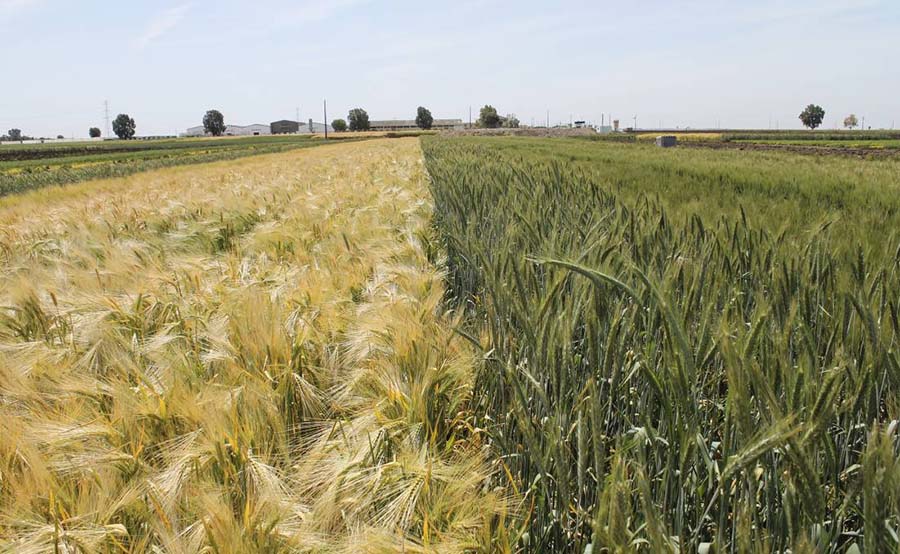In the 'numbers game' of international plant pre-breeding, a step change in the way genebanks are searched has increased the odds of important trait discovery for grain growers.
The approach, used to rapidly and efficiently facilitate novel gene discovery, is called the Focused Identification of Germplasm Strategy (FIGS) and it was developed with GRDC investment.
For plant breeders exploring global gene pools brimming with old, locally-adapted farmer varieties (landraces) and ancient, wild crop relatives, it's the genebank equivalent of the Google search engine - revolutionising access to genetic information.
International Center for Agricultural Research in the Dry Areas (ICARDA) senior scientist, Zakaria Kehel, says the premise of the trait-homing search engine is that particular adaptations are linked to the conditions in which plants evolve.

ICARDA senior scientist Zakaria Kehel is delivering germplasm sets, targeting priority traits, to the Australian grains research community as part of the Focused Identification of Germplasm Strategy (FIGS). Photo: Clarisa Collis
In other words, the evolutionary link between growing conditions and different crop adaptations can be used to determine the likely location of genetic traits, both geographically and within the vast global catalogue of plant genes.
"Adaptive plant traits evolve over time," Dr Kehel says.
"They are unique to the environmental conditions at specific locations where old populations of farmer varieties (landraces) or crop wild relatives are grown over numerous generations.
"So it is likely a relationship exists between the adaptive traits in a given location and the environmental parameters that impose selection pressure for the emergence of those traits."
Dr Kehel says the FIGS method is set to become an "industry standard", replacing the conventional approach used to search large germplasm collections for rare alleles or variant genes.
The traditional method, which Dr Kehel describes as "looking for a needle in a haystack" sees pre-breeders, breeders and genebank curators access germplasm based on semi-random selections from core genebank collections.
Global banks
Putting the scale of these collections into perspective, the world's 1750 agricultural genebanks contain more than 7.5 million crop accessions and their wild relatives.
"Pre-breeders simply don't have the resources to evaluate entire germplasm collections," Dr Kehel says.
"Compared with FIGS, the traditional method decreases the likelihood of finding useful new variation in genebanks.
"In turn, this increases the time and cost of 'introgressing' (transferring) new traits into Australian varieties."
The FIGS program, however, combines agro-ecological information with data on plant characteristics to identify sets of plant genotypes likely to contain traits being targeted by plant breeders.
These "best bet" sets of germplasm considerably lift the potential for finding genetic resources that can be used to address the challenges that climate change poses to agroecological systems, Dr Kehel says.
For instance, trait discovery is needed to supply the demand for new cultivars able to tolerate drought and heat stress, which are predicted to rise. It is also needed to help Australian growers tackle the emergence of virulent pest and disease biotypes expected to emerge under changing climatic conditions.
Helping grain growers face these and other cropping constraints is GRDC-invested research fine-tuning the FIGS methodology at ICARDA.
Leading the project, Morocco-based Dr Kehel and his team have delivered a series of new germplasm subsets for cereals and pulses to Australian pre-breeders and breeders looking for new sources of adaptive traits.
Germplasm sets
The germplasm sets were developed, targeting 'priority traits' identified by the Australian grains industry, for three cereal crops (bread wheat, durum wheat and barley) and four pulse crops (chickpeas, lentils, faba beans and field peas).

ICARDA researchers use FIGS to find 'priority traits' identified by the Australian grains industry in a range of crops, including bread wheat, durum wheat, barley, chickpeas, lentils, faba beans and field peas. Photo: Clarisa Collis
Researchers and commercial breeders screen and validate the traits they contain for transfer to experimental plant lines and, ultimately, new variety development.
Targeted traits range from tolerance to abiotic (non-living) stresses, such as drought, heat, frost and acid soils, to resistance to biotic (living) stresses, such as pests and diseases.
For example, batches of cereal germplasm sent to the Horsham-based Australian Grains Genebank included traits that are potentially resistant to Russian wheat aphid, leaf rust, net blotch (spot and net forms), septoria tritici blotch, crown rot and fusarium head blight.
The ICARDA team also developed three separate sets of germplasm, targeting traits for abiotic tolerance, particularly heat and drought, for Australia's northern, southern and western growing regions.
Complete with 'passport data' detailing trait selection criteria, such as phenotypic information, the FIGS sets were provided through the CIMMYT Australia ICARDA Germplasm Evaluation (CAIGE) project.
This country's portal to international wheat and barley germplasm from the ICARDA and CIMMYT breeding programs, CAIGE gives the Australian grains research community access to much of the world's genetic crop resources, including FIGS.
FIGS discovery
ICARDA head of genetic resources Dr Ahmed Amri says the FIGS method was used to "mine" from the ICARDA genebank new sources of genetic resistance to the major cereal pest, called sunn pest (Eurygaster integriceps).
This destructive insect, prevalent across Central and West Asia, North Africa and eastern Europe, is thought to annually infect 15 million hectares of wheat worldwide.
High infestation pressure can cause crop failure, but even low pressure can ruin flour quality because the pest injects chemicals into grain while feeding.

Dr Ahmed Amri says FIGS was used to discover new traits for sunn pest resistance stored inside the ICARDA gene bank's vast collection of genetic plant material. Photo: Clarisa Collis
Although the insect has not yet been detected in Australia, it is the focus of GRDC-invested, pre-emptive, pre-breeding research to help shield this country's grain growers from the threat of a sunn pest incursion.
To this end, Dr Amri says ICARDA researchers used the FIGS method to identify 534 wheat accessions, potentially resistant to the pest, in genebank material collected from Central Asia's pest-prone regions of Afghanistan and Tajikistan.
Putting the sunn pest-resilience of these plant lines to the test inside mesh cages as part of field trials at ICARDA's Tel Hadya research station in Syria, the research team advanced the best-performing accessions to ICARDA wheat breeding programs.
The pest-resistant traits contained within eight of these plant lines are now available for introgression into new wheat cultivars being developed through Australian wheat breeding programs.
ICARDA
Established in 1975, ICARDA is an international R&D organisation that aims to improve food, nutritional and water security, lift environmental health and reduce poverty in non-tropical dry areas.
*NOTE: Clarisa Collis travelled to Morocco with assistance from the Crawford Fund, as the 2018 winner of the Crawford Fund Food Security Journalism Award.
More information: Zakaria Kehel, z.kehel@cgiar.org; Ahmed Amri, a.amri@cgiar.org

























































